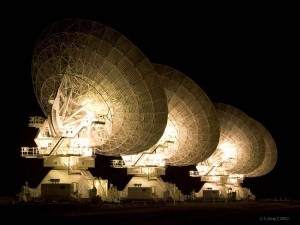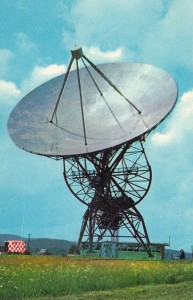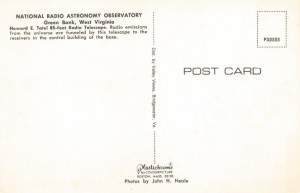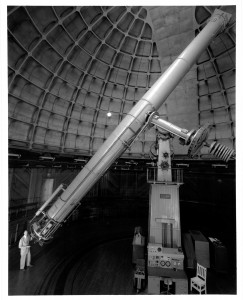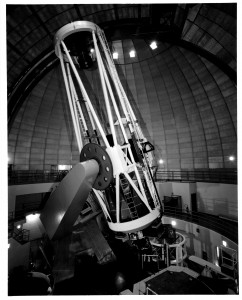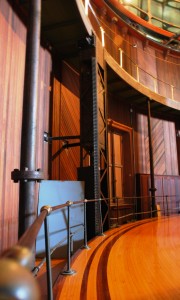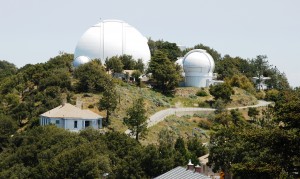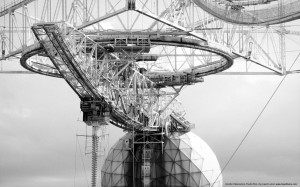Wallpaper Wednesday
1 06 2011Obviously, I have a thing for the architecture of radio astronomy. I blame my appreciation for the dish on COMSAT first, NRAO second, and only those who grew up in the Okanogan know why (unless you followed the links in this sentence). The image above shows four of the six 22-m antennae that comprise the Australia Compact Telescope Array at the Paul Wild Observatory near Narrabri, NSW, Australia. My favorite part of the observatory’s website is the ATCA Live! page, which tells me what the array is currently tracking (“As you read this astronomers are observing the source HD135344AB which has an azimuth of 247.3 degrees and an elevation of 60.1 degrees. The telescope is setup to observe at 17000 and 19000 MHz simultaneously.”). There’s also a nice archive of construction and upgrade photos available for public viewing online. I can’t see finding myself in Narrabri Shire anytime soon, but if you’re in the neighborhood (500 km northwest of Sydney), hit the Visitors Center: always open, admission is free.
Comments : Comments Off on Wallpaper Wednesday
Categories : Telescopes, Wallpaper
NRAO Green Bank
27 05 2011Wednesday’s mail brought me this “vintage” postcard of the Howard E. Tatel Radio Telescope. Built in 1958, the Tatel was the first major radio telescope at the National Radio Astronomy Observatory (NRAO) in Green Bank, West Virginia. Also known as “85-1,” the scope has served as a fixed element in the Green Bank Interferometer (GBI) since 1964.
Comments : Comments Off on NRAO Green Bank
Categories : Telescopes
Lick Observatory Historic Photos
26 05 2011A look at a few of the photos I picked up in California last week:
Comments : Comments Off on Lick Observatory Historic Photos
Categories : Lick Observatory, Observatories, Telescopes
Lick Observatory
22 05 2011Life unexpectedly detoured me through central California last week, so I thought I would take advantage of its (relative) proximity to visit Lick Observatory. The observatory is draped across the uppermost peaks of Mt. Hamilton in the Diablo Range east of San Jose. It’s open to the public on most days of the year, but hours and days are restricted during the winter months, so check the opening schedule before making the drive.
The daytime public program is focused on the historic instruments of the observatory, especially the Great Refractor installed under the dome custom-built for it in 1887. This 36″ telescope, the lenses for which were ground by Alvan Clark & Son (the same workshop that ground the lenses for the refractors at the Yerkes and Cincinnati observatories), lives in the largest of two domes flanking the Main Building of the observatory. A 12″ reflector that had been purchased second-hand from Alvan Clark originally lived in the smaller dome at the opposite end of the building; it now houses the 40″ Nickel Reflector. One has to wonder what instrumental astronomy would have looked like in the U.S. at the end of the nineteenth century had Alvan Clark not been around to polish the needed lenses and mirrors.
As you can see from the photo above, the Great Refractor was protected by a dome that was designed with a concern for aesthetics as much as functionality. The underside of the dome was tinted with a color meant to evoke the heavens and the walls were finished with California redwood paneling. James Lick might’ve been an odd guy, but he knew his woodworking.
The floor of the observatory, which was finished with mahogany and ringed with brass railings, was designed to move up and down along a vertical system of spur gears. This cleverness allowed observers to stand on a solid surface while looking through the eyepiece of the telescope, rather than on top of a ladder as was customary with large instruments.
In addition to the guide-led program in the Main Building, there is also a small viewing gallery open to the public in the dome of the Shane 3-meter Reflector. I thought the gallery was under-used, in that the interpretive materials were limited, and public view of the instrument was partially blocked by unidentified objects. The most interesting part of the display was the absolutely ancient black-and-white publicity movie that talked about the early history of the instrument. The corners on Mt. Hamilton Road are so tight that they had to use a relay system to get the 120″ glass for the mirror to its destination, using a crane to transfer the glass from the bed of the truck approaching the corner to the truck waiting on the other side of the corner. You can see below that many of the corners are more than just simple switchbacks, they actually start to double-back on themselves.
As an architectural historian, I thought the public program was fascinating; I stood through it twice, in fact. As I was wandering around the larger complex, however, I couldn’t help but wish that public programs spent more time explicating current research and observing practices. I suppose it’s not very practical to demonstrate the Automated Planet Finder or the Katzman Automatic Imaging Telescope; most observational data is crunched with computers manned by tired postdocs. (Take a look at a panoramic view of the control room for the Shane 3-meter during an observing run, for instance. Not enough drama for tourists, I’m pretty sure.) But sometimes I wonder if programs focused on the historical leave the public with the feeling that little has changed in instrumental astronomy in the last century, or if it has, that those changes aren’t important or comprehensible. There are at least ten domes at Lick Observatory and new instruments are being added or adapted on a regular basis. I think if the University of California is depending on public dollars to fund the research at the observatory, it might be good to put more information about current research in visitors’ hands. I enjoyed the slide displays of recent discoveries and accomplishments that lined the halls of the Main Building, but I think it would be more effective to have some of those research goals articulated by the guide during public presentations.
Just a side note: if you’re driving up to Lick Observatory from San Jose, be careful. This is a very popular training route for cyclists (in fact, the Amgen Tour of California passed through the day before I went up), so don’t whip around those blind curves—it’s not nice to run over cyclists with your car.
Comments : Comments Off on Lick Observatory
Categories : Alvan Clark & Sons, Instruments, Lick Observatory, Observatories, Telescopes
Wallpaper Wednesday
18 05 2011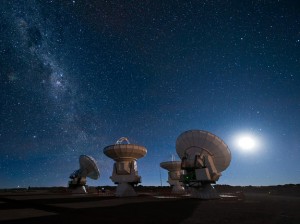
Atacama Large Millimeter/submillimeter Array (ALMA) antennae. Photo credit: ESO/José Francisco Salgado.
Today’s wallpaper comes to us courtesy of the European Southern Observatory (ESO) in Chile. What you see are four antennae completed as part of the Atacama Large Millimeter/submillimeter Array (ALMA). ESO and its international partners are in the process of constructing sixty-six of these antennae, all tuned to observe cold-body radiation with wavelengths of a millimeter or less. Radiation with such short wavelengths comes mostly from cold gas and dust clouds, in which stars are being born, or from early, cooling galaxies. Astronomers hope that the information gathered from these cold objects will bring us one step closer to understanding the origins of the universe.
ESO has provided a four-minute “trailer” about the project, available in multiple formats (HD always recommended if your system can handle it) in the video archive. Look for the brief glimpses of the construction equipment.
Comments : Comments Off on Wallpaper Wednesday
Categories : Telescopes, Wallpaper
New Jersey Astronomical Association
16 05 2011If you’re anywhere near Voorhees State Park in Lebanon Township, New Jersey, make plans to visit the Paul H. Robinson Observatory at 8:30 p.m., May 28, to hear Robert Zimmerman give a talk, “Unknown Stories From Space: Tales of Space Adventure Few Know About.” The observatory is located about an hour west of NYC, an hour east of Allentown, and an hour north of Trenton—accessible to more people than I can probably count. I’m not sure of Mr. Zimmerman’s exact topic (because the stories are unknown, of course), but if I had to guess, I’d say he was going to be talking a bit about the Hubble Telescope.
The Paul H. Robinson Observatory houses a 16-inch Cassegrain reflector, currently the largest telescope open to the public in New Jersey. I first noticed this instrument when I was doing local history research and discovered the massive mount and frame now in the Paul Robinson observatory was originally installed here in Bloomington at the Knightridge Observatory. The NJAA website doesn’t mention it, but according to IU history sources, the frame never operated properly. Even so, the founders of the NJAA paid $100 for the frame and mount (I think we can assume that it would cost considerably more for the system today). If the weather is clear, the telescope will be open to the public after Mr. Zimmerman’s talk. If you do happen to attend, please report back on the state of the frame and mount!
Comments : Comments Off on New Jersey Astronomical Association
Categories : Instruments, News, Observatories, Telescopes
Wallpaper Wednesday
11 05 2011
Construction of Mark I Telescope. Photo credit: Jodrell Bank Centre for Astrophysics, University of Manchester.
Today’s wallpaper is a photo taken during the construction of the 76-meter Mark I (Lovell) Telescope at Jodrell Bank. Designed by Bernard Lovell and completed in 1957, the Mark I was designed for mobility. Lovell had been using a transit telescope, a 66-meter stationary dish pointed at the overhead sky, in his search for cosmic rays. While the transit instrument was a suitable beginning, Lovell realized fairly quickly that his work was limited by an inability to re-direct the telescope’s attention to other parts of the sky.
The early construction photos are pretty stunning—the photographer(s) did a good job of capturing the complexity of the steelwork needed to support the dish, not to mention the intricacy of the scaffolding used by the construction workers. Several alterations have been made to the instrument since its completion: the railroad tracks on which it rotates have been replaced; the support structure has been shored up numerous times; it was given a new reflector in 1970-71 that significantly increased its functionality. The dish was resurfaced as recently as 2000-2003.
If you’re interested in viewing the Mark I(a)/Lovell telescope in person, check out the Jodrell Bank Discovery Centre online (there is no public access to the research labs at Jodrell Bank Observatory, but you can take a web tour). If you’re curious as to what the Lovell is observing right this moment, you can see a live update on the Jodrell Bank Telescope Status page. You can even follow the telescope on twitter (@LovellTelescope).
One last note: if you want to see a truly impressive grant application, read The Blue Book, Lovell’s research and funding proposal submitted to the Department of Scientific and Industrial Research in 1951. Would that everyone could write such a clear explanation of his or her work and its broader impact.
Comments : Comments Off on Wallpaper Wednesday
Categories : Instruments, Telescopes, Wallpaper
SKA Update
9 05 2011Good news in the paper this morning: India gets to join the SKA project, after all!
Comments : Comments Off on SKA Update
Categories : News, Telescopes
Fermi Large Area Telescope
30 04 2011
I saved this tweet from Jodcaster Jennifer Gupta because it made me feel good. Sometimes it’s easy to understand WHAT and instrument and WHY it does it, but the HOW can be completely incomprehensible (more so to me than Ms. Gupta, I suspect).
The Large Area Telescope (LAT) to which this tweet refers is the primary instrument on the Fermi Gamma Ray Space Telescope spacecraft.* As the name of the satellite suggests, the Fermi instruments are directed toward detecting gamma radiation sources. Gamma radiation (aka gamma rays) is electromagnetic radiation with a high frequency/short wavelength. In fact, gamma rays are the highest-energy forms of light in the electromagnetic spectrum. The Fermi satellite follows decades of gamma ray detection and analysis through various means by NASA, but it is unique in that it’s the first instrument to survey the entire sky every day for gamma radiation.
The entire sky? Yes, but in search of some more specific targets: blazars, active galaxies, gamma-ray bursts, neutron stars, cosmic rays, supernova remnants, our own galaxy and solar system, and….wait for it….dark matter!
The LAT is used to detect gamma rays using a process called “pair production,” which is governed by Einstein’s statement of the equivalence of energy and matter (E=mc2). Gamma rays are pure energy. When gamma radiation hits the tungsten detector in the Large Area Telescope, it creates a pair of subatomic particles, one electron and one positron. Silicon tracking detectors project the path of these particles backward to the source of the gamma ray. A third detector, the calorimeter, measures the energy of the particles, which is dependent on the energy of the gamma ray.
The gamma rays detected and measured by the LAT come from a variety of objects—different kinds of active galactic nuclei, for example, like radio galaxies, Seyfert galaxies, quasars, and blazars. But the science team behind the LAT expect blazars to be the greatest producers of detectable/measurable gamma rays. Blazars (blazing quasi-stellar objects) are very compact quasars (quasi-stellar objects) with supermassive black holes at the center of elliptical galaxies. Blazars are very high energy—maybe the highest energy objects in the universe—and their jets appear to be aimed toward earth. Analysis of these jets with the Fermi instruments should tell us more about the origins and structure of the universe. As GLAST Interdisciplinary Scientist Charles Dermer of the Naval Research Laboratory in Washington, D.C., once noted “When GLAST detects a blazar, it is monitoring violent activity from a black hole taking place in the distant past. Understanding gamma rays from these sources is a form of black hole archeology that reveals the high-energy history of our Universe.”
The LAT is at least 30 times more sensitive than any other instrument sent into space for measuring gamma rays, so it’s no wonder that the results have been so phenomenal. Although the write-ups of the results aren’t directed toward a popular audience (you can read some of the recent publications at arXiv.org), occasionally the science team finds something so unusual it makes the daily news report. For instance, earlier this year, the LAT detected two gamma-ray flares in the Crab Nebula. I loved the press release for that discovery, which noted the science team was “dumbfounded” by the high-energy flares. Can’t you see a room full of post-docs in ratty t-shirts and jeans staring at their computer screens, saying, “WTF? I seriously need to get more sleep!”?
If you want to delve into the Fermi spacecraft in more detail without battling through a course in particle physics first, NASA has a fantastic guide on the subject for science writers. It’s almost 50 pages long, but so interesting, I have to recommend it for reading at dinner table.
*The spacecraft was originally named the Gamma-Ray Large Area Space Telescope (GLAST), but was renamed for Enrico Fermi in August 2008.
Comments : Comments Off on Fermi Large Area Telescope
Categories : Instruments, Telescopes
Wallpaper Wednesday
27 04 2011An amazing view of the superstructure of the 305-meter radio telescope located near the town of Arecibo, Puerto Rico. This telescope caught my eye for a couple of reasons. First, well, just look at that engineering. Suspension cables, truss work, the lattice work on the Gregorian dome…the construction photos make for fantastic viewing
The image above shows five major components of the telescope’s superstructure:
1) We’re looking at the underside of a triangular “platform” that weighs some 900 tons. The platform is suspended on 18 steel cables. Six more cables connect the corners (two at each corner) to jacks used to adjust height of platform (millimeter by millimeter).
2) The circular structure on the underside of the triangular platform is the track on which the 328-foot azimuth arm rotates.
3) The azimuth arm (the bowed trusswork) is another track system. The carriage house travels on one end of the track, the Gregorian dome travels on the opposite end.
4) The carriage house serves as the terminus for various linear antennae tuned to a narrow band of frequencies. The antennae are directed downward, toward a massive reflector dish.
5) The Gregorian dome is a complicated beast but it essentially enables the spherical reflector of the telescope to behave as if it was a parabolic reflector (the most common shape used for radio telescopes). That odd hanging half-dome contains a multi-beam receiver that can look at seven reflected beams at simultaneously (as opposed to a single-signal linear antenna).
The second reason that observatory caught my eye is that it was designed to take advantage of the geological formations of the site. That huge dish is built on a natural karst (again, the construction photos tell a good story). It’s good to know karst land is good for something other than swallowing holes, collapsing mines, and breaking legs.
In recent years, the telescope has been scrambling for funding, but the NSF has decided to fund it through at least 2016. That gives me five years to figure out a way to go see this place in person.
Comments : Comments Off on Wallpaper Wednesday
Categories : Telescopes, Wallpaper
